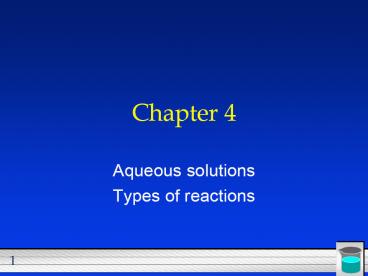Water Soluble Compounds PowerPoint PPT Presentation
1 / 37
Title: Water Soluble Compounds
1
(No Transcript)
2
Section 4.1
3
Section 4.1
4
Section 4.1
5
Section 4.1
6
Section 4.1
7
Section 4.1
8
Section 4.1
9
Section 4.1
Water Soluble Compounds
Strong Electrolytes
Weak Electrolytes
Non Electrolytes
Weak acids And Weak Bases Example HC2H3O2 HF NH3
Molecular Compounds Example CH3OH C2H5OH
(ethanol) C6H12O6 (sugar)
Strong acids And Strong Bases Example HNO3 H2SO4
NaOH Ba(OH)2
Ionic Compounds Example NaCl KNO3 KF
10
Section 4.2
11
Section 4.2
12
Section 4.2
13
Section 4.2
14
Section 4.2
15
Section 4.2
16
Section 4.2
17
Section 4.2
18
Acids and Bases
Section 4.3
- An acid is a molecular substance that ionizes to
form a hydrogen ion (H) and increases the
concentration of aqueous H ions when it is
dissolved in water.
All other acids are considered weak
19
Acids and Bases
Section 4.3
- A base is a substance that increases the
concentration of aqueous OH ions when it is
dissolved in water. Bases can be either ionic or
molecular substances - Bases accept H ions
Strong Bases LiOH Ca(OH)2
NaOH Sr(OH)2 KOH Ba(OH)2 RbOH CsOH
Weak Bases
20
Acids and Bases
Section 4.3
- An acid and a base can react with one another to
form a molecular compound and a salt. The
combination of hydrochloric acid and sodium
hydroxide is a familiar neutralization reaction.
Three equations are written for Acid/Base
reactions
Molecular Equation Complete Ionic H
Cl- Na OH- ? H2O(l) Na
Cl- Net Ionic H Cl- ? H2O(l)
All in aqueous form. If present as a solid,
the entire reactant must be written.
21
Acids and Bases
Section 4.3
- Not all acid/base reactions are easy to identify
- Not all produce salt and water
- The molecular compound produced by the reaction
of an acid and a base can also be a gas.
Example 1
Example 2
HCl NaHCO3 ? NaCl H2CO3 H2CO3
decomposes into H2CO3 ? H2O(l) CO2
Net Ionic 2H S2- ? H2S(g)
Complete Ionic HCl NaHCO3 ? NaCl
H2CO3 H2O Net Ionic H
HCO3- ? H2O CO2
22
REDOX
Section 4.4
- In addition to precipitation and neutralization
reactions, aqueous ions can participate in
oxidation-reduction reactions. Oxidation-reduction
reactions involve the transfer of electrons from
one chemical species to another. A piece of
calcium metal, for example, dissolves in aqueous
acid.
23
Rule 1
Section 4.4
- The oxidation number of an individual atom in
the free state of the element 0 - Seven elements exist as diatomic molecules in
the free state - Br I N Cl H O F The diatomic 7
- Examples Mg He Kr I2
Cl2
24
Rule 2
Section 4.4
- The oxidation number of a monatomic ion is equal
to the charge of the ion. - Example Mg2 2
- F- 1-
25
Rule 3
Section 4.4
- The sum of the oxidation numbers for a polyatomic
ion the charge of the ion - Example SO42- The total must equal 2-
- Therefore S is a 6 and O is 2-
- S 6 and 4 O each at 2- totals 8-.
- Adding 6 and 8- total 2-.
26
Section 4.4
Rule 4 The sum of the oxidation numbers for a
compound must equal 0 Example Cu2S The
total from the Cu and S must total 0 Therefore
the Cu is 1 and S is 2-
27
Section 4.4
Rules to Remember Group 1 elements make 1 Group
2 elements make 2 Group 17 elements make
1- Oxygen is 99 always 2- Metals are listed
before nonmentals Metals are and nonmetals
are -----
28
REDOX - Example 1
Section 4.4
0
2
2
0
Zn(s) Cu2(aq) ? Zn2(aq) Cu(s)
Reducing Agent
Which is oxidized? Which is reduced?
Zn(s) 0 ? 2 LEO!
Cu2 2 ? 0 GER!
Oxidizing Agent
29
REDOX Example 2
Section 4.4
-4 total, -2 each
-2 total, -1 each
2 total, 1 each
4
-1
1
2
0
-2
MnO2 4HCl ? MnCl2 Cl2 2H2O
Reducing Agent
Cl- -1 ? 0 LEO
Which is oxidized? Which is reduced?
Oxidizing Agent
Mn4 4 ? 2 GER
30
Writing Net Ionic Equations
Section 4.4
- We can write also write a net equation for this
type of reaction
MnO2 4HCl ? MnCl2 Cl2 2H2O
Net Equation
Mn4 4Cl- ? Mn2 Cl2
31
How Can We Tell if a Reaction Will Occur?
Section 4.4
- The activity series!
- Elements higher up will react with the ion of the
metal below it - For Example
- Pb(s) will displace Cu in solution
- However, Cu(s) will not replace Pb2 in solution
32
Predict if the Following Reactions will occur
Section 4.4
- Mg(s) Al(NO3)3(aq) ?
- Zn(s) Na2SO4(aq) ?
- Sn(s) HCl(aq) ?
- Au(s) HCl(aq) ?
33
Molarity
Section 4.5
- Quantifies concentration of a solution
- Basic Equation
Molarity moles solute volume
of solution in liters
34
Molarity practice problem
Section 4.5
- How many grams of Na2SO4 are there in 15 mL of
0.50 M Na2SO4? - How many mL of 0.50 M Na2SO4 solution are
required to supply 0.038 mol of this salt?
35
Dilution
Section 4.5
- Dillution is used to reduce the concentration of
stock solutions - Add water to concentrated stock solutions to
obtain a solution of lower concentration - Key idea the number of moles of solute remains
unchanged..so
Mi x Vi Mf x Vf
36
Dilution practice problem
Section 4.5
- How many milliliters of 5.0 M K2Cr2O7 solution
must be diluted in order to prepare 250 mL of
0.10 M solution?
37
Section 4.6 Titrations
- We will skip this for now and cover titration
later in the year

